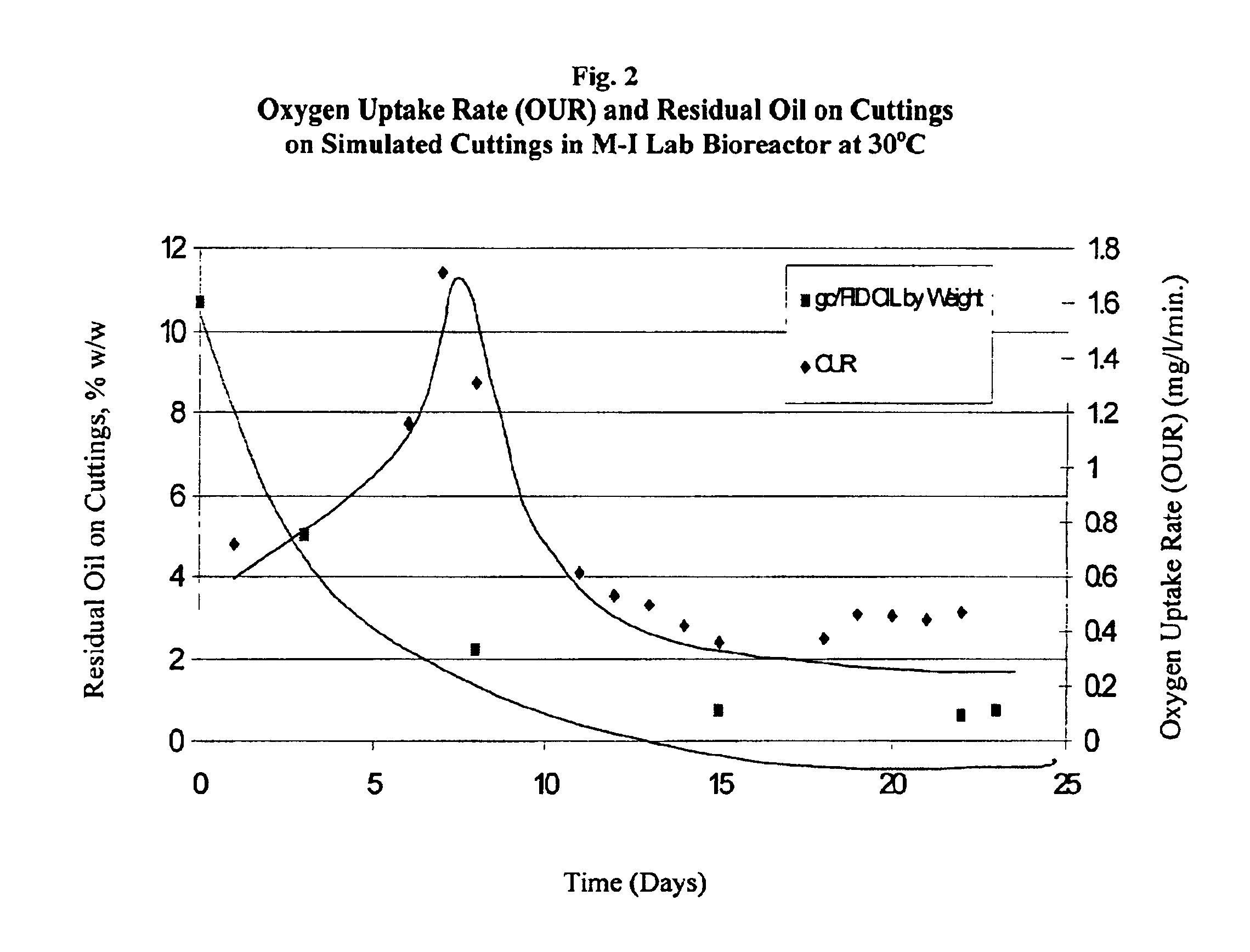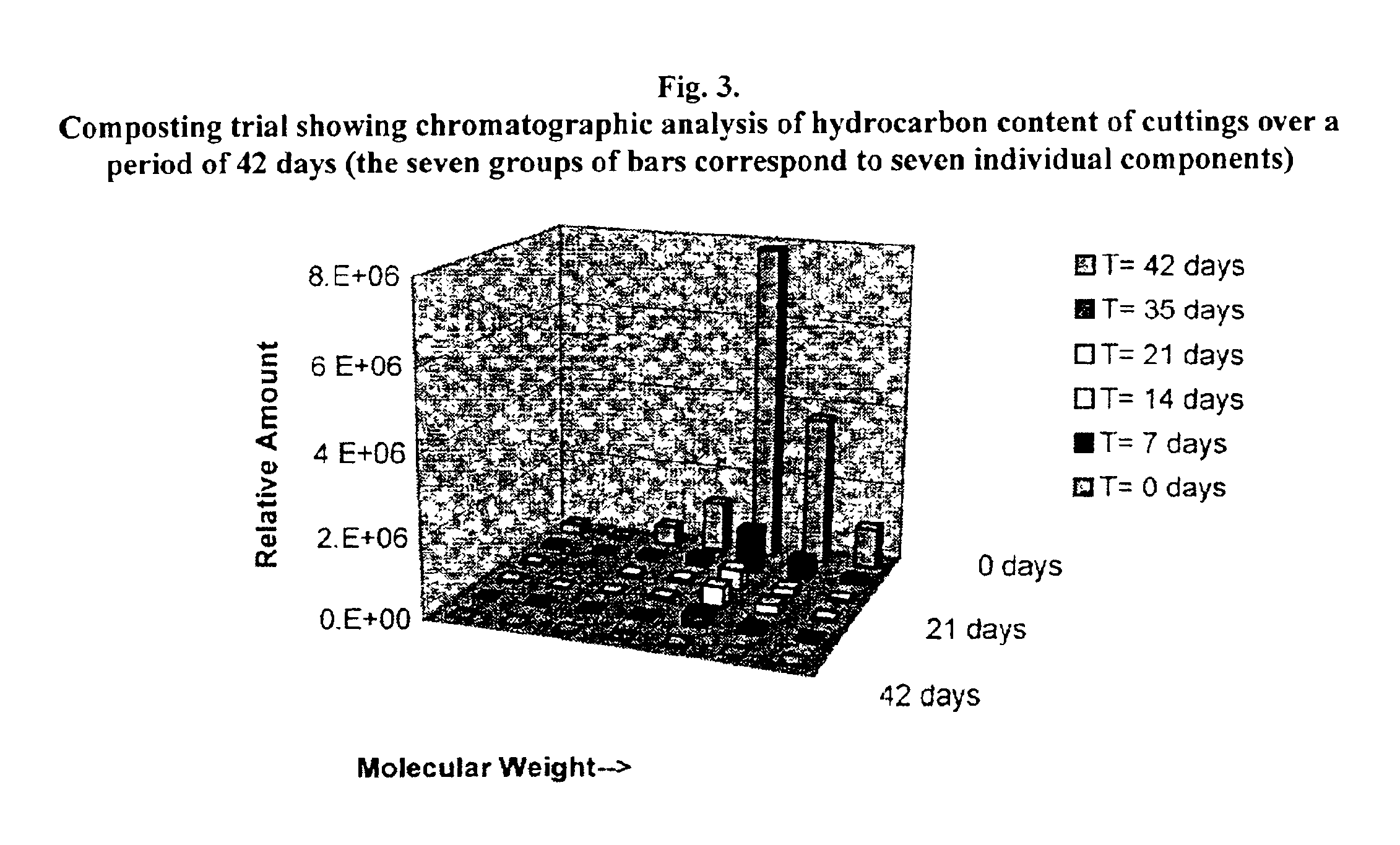Vermiculture compositions
a technology of compositions and vermiculture, applied in the field of vermiculture compositions, can solve the problems of smothering any marine life, harmful to marine life, and traditional oleaginous drilling fluids, as well as known
- Summary
- Abstract
- Description
- Claims
- Application Information
AI Technical Summary
Benefits of technology
Problems solved by technology
Method used
Image
Examples
example 1
[0074]The following illustrative embodiment of the present invention demonstrates a method of preparing the oleaginous drilling fluid, a suitable test procedure for operation and monitoring of a lab-scale bioreactor, and biodegradability test results of oleaginous base fluids.
[0075]Drilling Fluid Mixing & Testing Procedure
[0076]Test fluids were mixed with a Hamilton Beach (HB) mixer over a period of 1 hr, and then exposed to high shear with a Silverson mixer set at 7000 rpm until the slurry reached 150° F. Property measurements consisted of initial API Electrical Stability (ES) and API standard rheology at 150° F. After heat-aging (rolling) the fluids for 16 hr at 250° F., ES, rheology (again at 150° F.) and API standard HTHP fluid loss at 250° F. were measured. The fluid density was approximately 13.0 lb / gal, OWR=70 / 30, and the water activity of the internal water phase=0.86 to 0.76 (equivalent to 18 to 24% CaCl2).
[0077]More rigorous testing included prolonged stability at 300° F. ...
example 2
[0098]The following illustrative embodiment of the present invention demonstrates that the oleaginous drilling fluids of the present invention are useful as drilling fluids.
[0099]Standard fluid properties of three 13 lb / gal, 70 / 30 SWR (Synthetic / Water Ratio) formulations, one with an acetate brine (Formulation A), one with a nitrate brine (Formulation N) and the other a nitrate / acetate blended brine (Formulation NA) are shown in Table 3. A conventional high-performance diesel-based mud with CaCl2 brine internal phase gives standard properties that are very similar. The three formulations in Table 3 were also hot-rolled for 16 hr at 300° F., as well as 250° F. with essentially no degradation in rheology or electrical stability (ES).
[0100]Biodegradability and toxicity of Formulations A and N are contrasted with those of typical diesel / CaCl2 / barite fluid in Table 4. The leading rate on the test soil in Table 4 was 6% w / w. These results show that fluids A and N both are consistently mor...
example 3
[0104]The following illustrative embodiment of the present invention demonstrates the use of a bioreactor for the bioremediation of drilling cuttings.
[0105]Simulated drill cuttings thoroughly coated with Formulation N were slurrified and treated in the lab bioreactor at room temperature (25° C.). No nutrients were added and only moderate aeration was used. The level of retained fluid on cuttings (ROC) was initially about 11% w / w. A graphical representation of the exemplary results is shown in FIG. 2. Ecotoxicity data, with a loading rate on the test soil of 6% w / w are shown in Table 4
TABLE 4Biodegradability, Toxicity & Electrical Conductivity of Formulations and Treated Cuttings6% w / w Loading on Topsoil from Southern Alberta GrasslandBiodegradability(65 days)Animal ToxicityAlfalfa Phytoxicty*Relative% Loss of%%%ElectricalExtractableSpringtailEarthworm% Seed% RootShootConductivitySystemHydrocarbonsSurvivalSurvivalEmergenceElongationMass(after 65 days)Formulation9880100100149971.0AFor...
PUM
 Login to View More
Login to View More Abstract
Description
Claims
Application Information
 Login to View More
Login to View More - R&D
- Intellectual Property
- Life Sciences
- Materials
- Tech Scout
- Unparalleled Data Quality
- Higher Quality Content
- 60% Fewer Hallucinations
Browse by: Latest US Patents, China's latest patents, Technical Efficacy Thesaurus, Application Domain, Technology Topic, Popular Technical Reports.
© 2025 PatSnap. All rights reserved.Legal|Privacy policy|Modern Slavery Act Transparency Statement|Sitemap|About US| Contact US: help@patsnap.com



